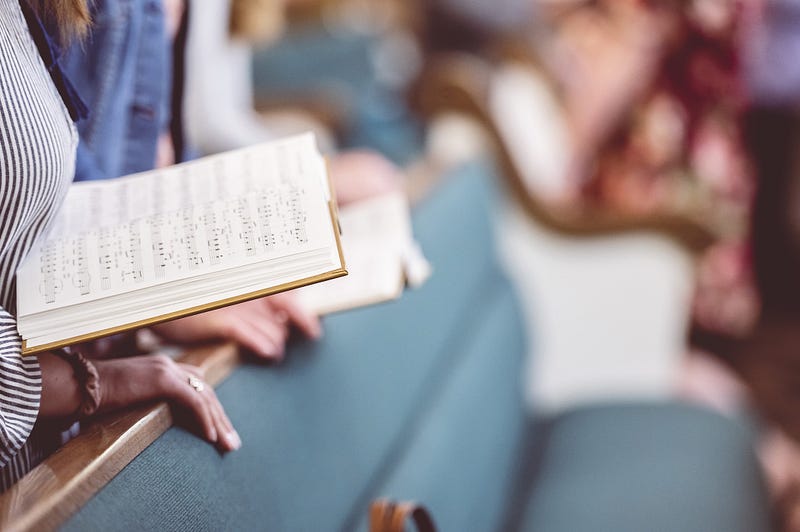The Transformative Power of Group Singing in Spiritual Spaces
Written on
Chapter 1: The Impact of Diversity in Worship
The church of my childhood was strikingly homogenous; in fact, it was entirely white. This wasn’t due to intentional segregation; rather, it mirrored the demographic makeup of our town, which could hardly be described as diverse. If you were to walk through our streets, you might think you were in a quaint Scandinavian village instead of a mid-sized town in northern Tasmania.
It’s a memory that stands out: the day three African men entered our chapel and took their places among the predominantly British congregation. Our group didn’t just look British; we sang with an unyielding uniformity that felt almost stifling. However, when the organ began playing the familiar hymn "All to Jesus I Surrender," the atmosphere shifted dramatically.
From behind me, a sound so sweet and unexpected caught my attention. My mother admonished me for staring, but the allure of that harmonious singing was irresistible. I doubt I was the only one captivated; the adults, too, were likely intrigued, albeit with a veneer of decorum that shielded their curiosity.
There, among the wooden pews, those three men harmonized beautifully, their voices rich and soulful, effortlessly rising above the usual congregational melody while enhancing it at the same time. I can’t articulate the feelings that stirred within my ten-year-old self—perhaps it was wonder.
That day, I developed a deep affection for that hymn, or more specifically, for the way it was sung in that moment. I later chose it for my baptism. Above all, I cherished the three men who introduced something truly special to our congregation: harmony.

The Science Behind Singing
Now that I’ve moved away from traditional Sunday services, what I miss most is the communal singing. There’s something undeniably uplifting about singing with a large group, especially when everyone is fully engaged with the lyrics.
As I’ve delved into the science of singing, I’ve learned that the experience transcends mere spirituality. Group singing, particularly in harmony, initiates a series of physiological and psychological reactions that foster feelings of joy and well-being.
Research utilizing neuroimaging techniques, such as functional magnetic resonance imaging (fMRI), has shown that listening to harmonious music activates brain regions associated with emotion, memory, and auditory processing. This suggests that harmony not only brings pleasure but also engages various cognitive and emotional faculties.
Moreover, studies indicate that singing together can elevate oxytocin levels—the so-called "love hormone"—which fosters bonding and social connections. This biological response illustrates why shared singing can cultivate a profound sense of unity among participants.
My vivid memories of those three African men and their harmonious contribution to our church are understandable in this light. A study from 2015 found that individuals who sang together for just an hour developed bonds akin to those formed between long-time friends. The researchers noted that such connections rarely occur among strangers in just an hour’s time, attributing this phenomenon to singing acting as a powerful ice-breaker.
Truly remarkable!
It is clear to me that the significance of singing extends well beyond mere enjoyment; it’s about forging connections. Furthermore, it serves as a potent tool to evoke specific responses from an audience, making it both beautiful and potentially perilous.
The Music of Manipulation
As a young Christian, I believed the warm sensations I experienced during communal singing were purely the presence of God—a divine response to a congregation lifting their voices in unison.
But over time, I discovered that similar euphoric moments could arise from singing at a football match. Reflecting on the times I stood at the altar, “giving my heart to Jesus,” I remember the emotive music, the gentle swell of keyboards, and a preacher’s voice urging, “What you feel inside is God knocking at your heart. Will you answer?”
That feeling was undeniably real. But was it truly God, or merely the music? Might it be a combination of both?
A Divine Mystery
Then I recall those three African gentlemen. Their singing exuded authenticity; eyes closed and hands raised (though not both, as that would have been too charismatic for our conservative setting). They weren’t performing; they were connecting with God and sharing their true selves with us.
They were the seasoning for an otherwise bland dish, a burst of color on a monochrome canvas.
Ultimately, I conclude that the act of singing together in harmony, with all its magical effects on our bodies, minds, and spirits, must be a gift from God. While others may exploit it for various agendas—both secular and spiritual—the essence remains: singing in harmony might serve as a metaphor for a world where everything feels right and everyone is united.
Could it be a glimpse of heaven?
I sincerely hope so.
Dan Foster is the author of “Leaving Church, Finding God: Discovering Faith Beyond Organized Religion.” The Backyard Church serves not just as a blog but as a genuine online community for those who have faith yet choose not to attend traditional churches. Join us today for more insights on life, faith, and spirituality. Sign up for my newsletter, and feel free to reach out with questions or story ideas at [email protected].
Chapter 2: The Joy of Collective Harmony
Singing in a group is a transformative experience that connects us deeply.
The first video, "A New Thing - Don't Miss it! | Sunday 14th February 2021 @ 11:00am - YouTube," explores the joy and significance of collective worship through song, emphasizing the need to appreciate these moments together.
The second video, "Anne Wilson - Sunday Sermons (Official Music Video) - YouTube," showcases the emotional power of music in a spiritual context, reminding us of the profound effects of harmonious singing.